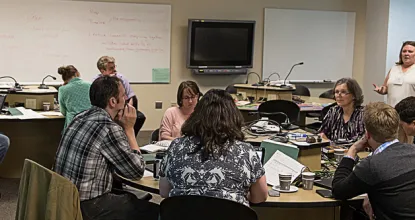Video generated by the HeyGen AI Platform
Creating a Personal AI Course Plan
Personal AI Course Plan Video (click on the image above to view)
As educators in an ever-evolving digital landscape, it's imperative that we acknowledge and adapt to the transformative capabilities of Generative AI within our teaching practices and disciplines. The emergence of this technology not only necessitates a reevaluation of our pedagogical strategies but also offers an unprecedented opportunity to enhance our productivity, student learning experiences, and assessment methodologies. In this spirit, it is encouraged that all faculty members develop a personal plan for addressing and integrating Generative AI into their courses. This plan should be reflective, adaptable, and aligned with core educational values of integrity, inclusivity, and innovation. Here is an example of a plan that works:
- Assessment of Current and Potential Use: Begin by evaluating how Generative AI can serve your course objectives. Identify tasks or activities where AI could improve efficiency, such as automating feedback on assignments, generating creative prompts, or curating personalized learning resources.
- Set Clear Guidelines for AI Use: Establish and communicate clear policies on the ethical use of Generative AI by students, distinguishing between acceptable aids and academic dishonesty. This includes defining appropriate contexts for AI assistance and the expectations for originality and critical engagement.
- Professional Development and Collaboration: Commit to continuous learning about the advancements in AI and its pedagogical applications. Participate in workshops, seminars, and discussions with peers to share strategies, challenges, and successes in integrating AI into teaching.
- Reflect and Iterate: Regularly reflect on the effectiveness of AI integration in your course, based on student feedback, learning outcomes, and your own observations. Be prepared to adapt your approach as technology evolves and new insights emerge.
In developing your plan, you should approach Generative AI not merely as a tool for efficiency but as a catalyst for reimagining the educational experience. By thoughtfully integrating this technology, you can create richer, more diverse learning environments that prepare our students for the complexities of the modern world, while simultaneously enhancing your own teaching practices and disciplinary engagements.
